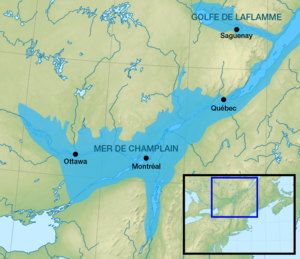Champlain Sea facts for kids
The Champlain Sea (also known as Mer de Champlain in French) was a huge, temporary sea that was once part of the Atlantic Ocean. It formed when giant glaciers melted at the end of the last Ice Age. This ancient sea covered parts of what are now the Canadian provinces of Quebec and Ontario, as well as parts of the American states of New York and Vermont.
How the Champlain Sea Formed
For thousands of years, massive ice sheets pushed the land down. When the glaciers melted at the end of the last Ice Age, the land was still pushed down. This meant that areas like the Saint Lawrence and Ottawa River valleys, and what is now Lake Champlain, were below sea level.
Ocean water flowed into these low areas, creating the Champlain Sea. Slowly, the land began to rise back up. This process is called isostatic rebound. As the land rose, the sea got smaller and eventually disappeared, leaving the land as it is today.
The Champlain Sea existed from about 13,000 years ago to about 10,000 years ago. During this time, it was continuously shrinking. At its largest, the sea reached as far south as Lake Champlain. It also stretched west past the city of Ottawa and up the Ottawa River past Pembroke.
Meltwater from the remaining glaciers flowed into the sea. This made the water a bit brackish, meaning it was a mix of fresh and salt water. Scientists believe the sea was once about 150 meters (490 feet) higher than the Saint Lawrence and Ottawa Rivers are today.
Evidence of the Ancient Sea
We know the Champlain Sea existed because of several clues left behind. One of the best clues is the huge clay plain found along the Ottawa and Saint Lawrence Rivers. This clay was deposited by the sea. It created special types of forests and large wetlands that we still see today.
Other evidence comes from fossils of sea animals. Scientists have found fossils of beluga whales, fin whales, and bowhead whales near the cities of Ottawa and Montreal. They have also found fossils of ocean fish like capelin.
The sea also left behind ancient raised shorelines. These are like old beach lines that are now much higher than current sea level. There are also special clay deposits called Leda clay in areas that were once deeper parts of the sea.
The northern edge of the Champlain Sea was in southern Quebec. Here, parts of the Canadian Shield form the Eardley Escarpment. This area, also known as the Gatineau Hills, still has unique plants that might have been there since the time of the sea.
See also
 In Spanish: Mar de Champlain para niños
In Spanish: Mar de Champlain para niños


